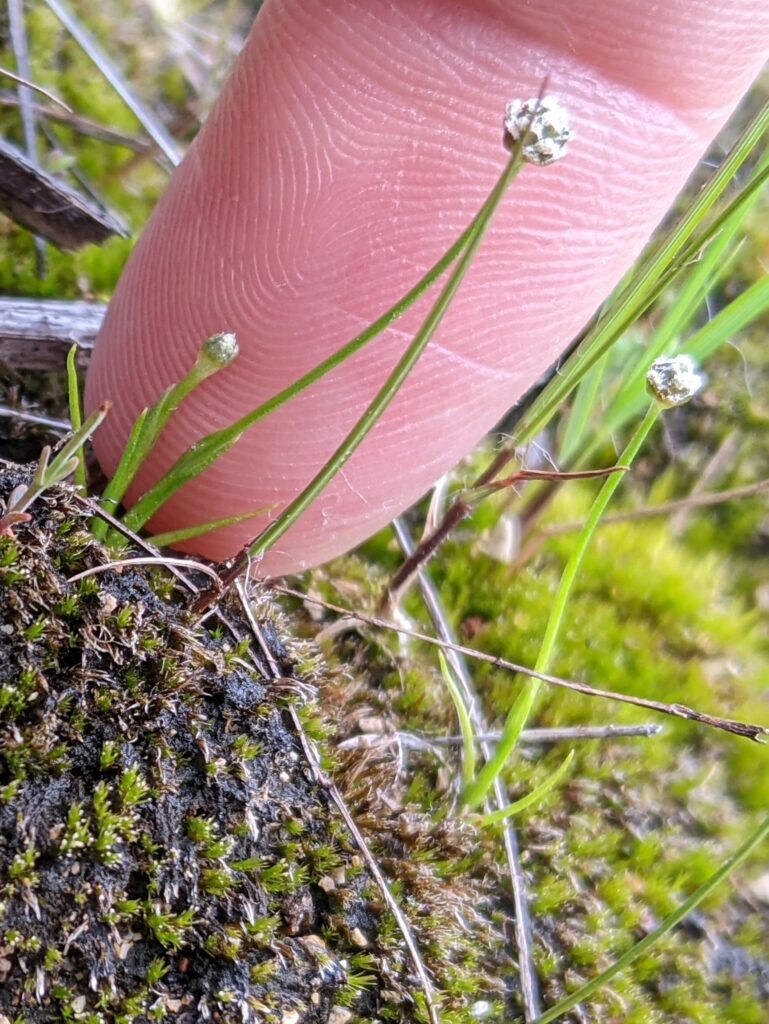
A well-known issue in global conservation efforts could be described as the Panda Problem. Programs that promote the protection of large, well-known mammals raise more funds than programs for smaller, less “charismatic” species. Yet even the smallest, nondescript species are part of the big picture of life on this planet–and deserve protection.
Conservation Program Assistant Rachel Carmickle knows this better than most. It’s why she is conducting extensive field studies and lab work to save a tiny, unpretentious plant known as Eriocaulon koernickianum or small-headed pipewort.
The Panda Problem
Multiple studies have confirmed that conservation work sometimes resembles middle school social life: popularity matters. Large mammals such as giant pandas, polar bears and African elephants receive the most attention from the public and therefore attract the most wildlife conservation funding.
One examination of data from the World Wildlife Fund-US found that donors are drawn to animals such as snow leopards and meerkats over less charismatic hog-nosed bats and red slender lorises. Nevertheless, hog-nosed bats are likely to attract more attention than plants. A review of data from the LIFE program, the European Union’s funding instrument for environmental and climate action, found that programs to protect endangered animals receive three times more funding than those for plants.
Even within plant conservation, some species are more popular than others. The same study noted, “species at northern latitudes, with broader ranges, and with blue/purple flowers received more funds regardless of their extinction risk,” stated the article.
The Less-than-Charismatic Small-headed Pipewort
The small-headed pipewort grows in the southern United States and has a limited range with isolated populations in bogs and other wetlands. Its flowers form an inconspicuous gray ball 3 to 4 mm in width–just a bit smaller than a grain of short-grain rice. So Eriocaulon koernickianum is facing an uphill climb to receive conservation attention.
Other strikes against it: small-headed pipewort has no known medical, industrial or agricultural use. It’s not particularly pretty, and gardeners aren’t hunting it down for display. It doesn’t exhibit any fascinating or unusual behavior that would intrigue scientists. It’s a just an ordinary little plant that grows in damp spots.
And yet Carmickle has devoted significant time in the last year and a half to the small-headed pipewort.
She has made multiple field trips to sites in Arkansas, Oklahoma and Texas to see if the plant is still alive in sites where it has been identified in the past. Many of these trips were fruitless, with no sign of the pipewort. Some of the wetlands in East Texas where the plant has historically been found have experienced very dry conditions the last few years, limiting the prospects for the plant.
Carmickle has also worked to develop a model that will help predict potential habitats, then conducted further field trips to refine the methods. She collected seeds that were added to the Conservation Seed Bank.
She also attempted to grow small-headed pipewort in the lab. The first attempt was deeply disappointing, with only a 7 percent success rate. A modified second attempt is still underway. Though Carmickle is keeping her fingers crossed, chances at such exploratory tests are limited given the rarity of the plant and the delicate dance between removing seed material from the wild for testing and leaving seeds in their native habitat to help sustain the population. Further research will be needed to determine if Eriocaulon koernickianum is a good candidate for future restoration in the wild.

In time, Carmickle hopes genetic analysis of Eriocaulon koernickianum would provide useful information about the plant, and sample materials will be collected and stored until either the Garden or some other research organization has funds to conduct this testing.
What Difference Does It Make?
Eriocaulon koernickianum is scheduled for a Federal Species Status Assessment in FY 2028, a process of the US Fish & Wildlife Service in which detailed information about a species is collected to inform Endangered Species Act decisions. Carmickle’s work will help provide a baseline assessment of the species across the western extent of its range. The goal is to “establish a clearer understanding of the current in situ distribution of the species …, to determine the species habitat requirements versus the current quality and quantity of the remaining habitats, and to estimate population size, abundance, density, growth, and decline.”
In other words, Carmickle’s data will help determine the true risk of Eriocaulon koernickianum in Oklahoma, Arkansas and Texas as well what steps to protect the species are most likely to be effective.
A larger question, however, remains. Why go to so much trouble to save a tiny, nondescript plant that most people have never heard of and wouldn’t miss if it were gone?
“Because Eriocaulon koernickianum is part of the natural world, and all of it matters,” says Director of Texas Plant Conservation Brooke Best. “If we let this one species go, where do we draw the line?”
The work of the Garden’s Research team, and the Texas Plant Conservation Program in particular, is to protect all of the plant life in the state, even the little plants that grow in isolated swamps. It is this type of work that will be discussed in depth at the Texas Plant Conservation Conference in August.
By all means, let’s save the pandas, and the snow leopards, and the polar bears. But the small-headed pipewort is just as deserving of conservation. It will continue to bloom in damp and hidden corners for years to come if Rachel Carmickle has anything to do with it.






